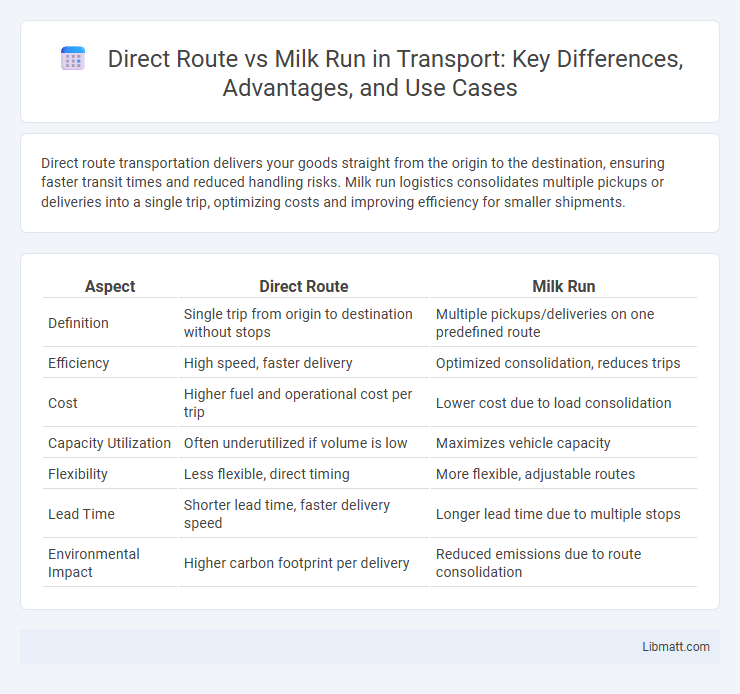Direct route transportation delivers your goods straight from the origin to the destination, ensuring faster transit times and reduced handling risks. Milk run logistics consolidates multiple pickups or deliveries into a single trip, optimizing costs and improving efficiency for smaller shipments.
Table of Comparison
| Aspect | Direct Route | Milk Run |
|---|---|---|
| Definition | Single trip from origin to destination without stops | Multiple pickups/deliveries on one predefined route |
| Efficiency | High speed, faster delivery | Optimized consolidation, reduces trips |
| Cost | Higher fuel and operational cost per trip | Lower cost due to load consolidation |
| Capacity Utilization | Often underutilized if volume is low | Maximizes vehicle capacity |
| Flexibility | Less flexible, direct timing | More flexible, adjustable routes |
| Lead Time | Shorter lead time, faster delivery speed | Longer lead time due to multiple stops |
| Environmental Impact | Higher carbon footprint per delivery | Reduced emissions due to route consolidation |
Understanding Direct Route and Milk Run Logistics
Direct route logistics involves transporting goods directly from the supplier to the destination without stops, ensuring faster delivery and reduced handling risks. Milk run logistics consolidates shipments from multiple suppliers into a single route, optimizing fuel efficiency and lowering transportation costs by minimizing empty runs. Your choice between these methods depends on factors like delivery speed requirements, shipment volume, and cost efficiency priorities.
Key Differences Between Direct Route and Milk Run
Direct routes offer the advantage of faster delivery times by transporting goods directly from the supplier to the destination without intermediate stops, ensuring reduced transit delays. Milk run logistics consolidate multiple pickups or deliveries into one route, optimizing fuel efficiency and reducing transportation costs through systematic scheduling and load management. Your choice between these methods hinges on balancing speed requirements with cost-efficiency and delivery volume.
Advantages of Direct Route Shipping
Direct route shipping minimizes transit time by reducing stops and handling, leading to faster delivery and improved product freshness. It enhances supply chain reliability by decreasing the risk of damage or loss during transport, ensuring goods arrive in optimal condition. This method also allows for better inventory control and accurate tracking, supporting just-in-time delivery strategies and reducing warehousing costs.
Benefits of Milk Run Delivery Systems
Milk run delivery systems offer significant cost savings by consolidating multiple shipments into a single route, reducing transportation expenses and fuel consumption. They increase operational efficiency through improved scheduling and inventory management, minimizing stockouts and excess inventory. Enhanced sustainability results from fewer emissions and reduced environmental impact compared to direct route deliveries.
Cost Efficiency: Direct Route vs Milk Run
Direct routes often yield higher cost efficiency for shipments with large volumes or time-sensitive deliveries by minimizing handling and transit times. Milk runs consolidate multiple deliveries into a single trip, reducing transportation costs through optimized load distribution but may increase lead times. Selecting between direct route and milk run depends on balancing shipment urgency and volume against overall transportation expenses.
Time Management in Direct Route and Milk Run
Direct route logistics minimize delivery time by enabling shipments to move straight from origin to destination, significantly reducing transit delays. Milk runs consolidate multiple pickups or deliveries in a single trip, optimizing load efficiency but often resulting in longer individual delivery times. Effective time management balances the speed advantage of direct routes with the cost-efficiency of milk runs to meet specific supply chain demands.
Impact on Inventory and Supply Chain
Direct route logistics reduce inventory holding by enabling faster, more frequent deliveries, which minimizes stock levels and lowers carrying costs. Milk run systems optimize supply chain efficiency by consolidating shipments from multiple suppliers, leading to smoother inventory flow and decreased safety stock requirements. Both strategies influence inventory turnover and overall supply chain responsiveness, with direct routes favoring speed and flexibility, while milk runs enhance cost savings and resource utilization.
Environmental Considerations: Direct vs Milk Run
Direct routes reduce carbon emissions by minimizing travel distance and time, leading to lower fuel consumption per shipment. Milk run logistics optimize efficiency by consolidating multiple deliveries into a single trip, decreasing the total number of vehicle miles traveled and reducing overall environmental impact. Choosing between direct routes and milk runs depends on balancing faster delivery times with the goal of minimizing greenhouse gas emissions in supply chain operations.
Choosing the Right Method for Your Business
Selecting between a direct route and a milk run depends on your business's delivery volume and frequency. Direct routes offer faster, point-to-point shipping ideal for urgent or high-priority shipments, while milk runs optimize costs and efficiency by consolidating multiple deliveries in a single trip. Understanding your supply chain needs ensures you choose the method that maximizes operational efficiency and cost savings for your business.
Future Trends in Logistics: Direct Route and Milk Run
Future trends in logistics emphasize increased adoption of direct route shipments to enhance speed and reduce handling incidents, supported by real-time tracking and AI-driven route optimization. Milk run strategies continue evolving with sustainable practices, integrating electric vehicles and shared loads to minimize carbon footprints and operational costs. Your supply chain can benefit from combining these methods, leveraging data analytics to balance efficiency with environmental impact.
direct route vs milk run Infographic

 libmatt.com
libmatt.com